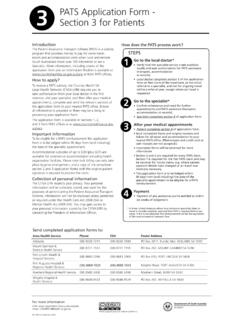Transcription of Guidance for Police and Youth Offending Teams - GOV.UK
1 Youth Cautions Guidance for Police and Youth Offending Teams Effective from: 8th April 2013. Youth Cautions Guidance for Police and Youth Offending Teams Contents 1. Introduction and 5. 2. Scope and status of this 6. 3. Agencies involved in Youth Cautions .. 7. 4. Decision making .. 8. Group Offences .. 11. Multiple 11. 18 year olds .. 11. 5. Use of Bail .. 12. Bail 12. Reasons for 12. Bail for assessment .. 12. Bail for delivery .. 13. Length of the bail period .. 13. 6. Liaison between Police and YOTs .. 15. Local Protocols .. 15. Notification regarding offenders and 15. Sharing Police Information with 16. 7. Involvement of Victims .. 17. 8. YOT assessments .. 18. Assessing for suitability for a Youth Caution .. 18. YOT assessment following decision to administer a Youth Caution .. 18. Undertaking the assessment .. 18. Views of the 19. 9. Delivery of Youth Cautions .. 20. Venues.
2 20. Category of Police 20. Explaining the effect of Youth 21. Appropriate adults .. 22. Signed records .. 22. Restorative justice .. 22. 3. Youth Cautions Guidance for Police and Youth Offending Teams 10. Intervention programmes ..23. Citable/non-citable Devising intervention 11. Other issues ..26. Monitoring and evaluation ..26. Fingerprints, photographs and Recording Youth Cautions ..26. Rehabilitation of Offenders Act 1974 ..26. Sexual Offences Act Non- Police prosecuting agencies ..27. Transitional Arrangements ..27. 4. Youth Cautions Guidance for Police and Youth Offending Teams 1. Introduction and legislation This Guidance provides advice for the Police and Youth Offending Teams on the operation of Youth Cautions. Youth Cautions were introduced by section 135 of the Legal Aid, Sentencing and Punishment of Offenders Act 2012 (the 2012 Act) which inserts section 66ZA and 66ZB into the Crime and Disorder Act 1998.
3 (the 1998 Act). The relevant legislation can be found at Annex A. The 2012 Act abolishes reprimands and warnings that together were known as the Final Warning Scheme. Following commencement of the 2012 Act reprimands and warnings should not be issued to young offenders. Youth Cautions are a formal out-of-court disposal that can be used as an alternative to prosecution for young offenders (aged 10 to 17) in certain circumstances. A Youth Caution may be given for any offence where the young offender admits an offence, there is sufficient evidence for a realistic prospect of conviction but it is not in the public interest to prosecute. Youth Cautions aim to provide a proportionate and effective resolution to Offending and support the principle statutory aim of the Youth justice system of preventing Offending by children and young people. 1. Youth Cautions are intended to allow a more flexible response to Offending than the preceding Final Warning Scheme.
4 Youth Cautions and other out-of-court disposals such as Youth Conditional Cautions do not have to be used in a set order and they are available if a young person has been previously convicted. Following a Youth Caution, the Police have a statutory duty to refer the young offender to the Youth Offending team (YOT). For a second or subsequent Youth Caution, or where a young person has previously received a Youth Conditional Caution, the YOT has a statutory duty to carry out an assessment of the young offender and consider putting in place an intervention programme aimed at preventing re- Offending . The YOT may carry out an assessment and offer a rehabilitation programme for a Youth who has never received a Youth Caution or Youth Conditional Caution at their discretion. The interventions attached to a Youth Caution are not conditional and there is no separate penalty for failing to comply with them, however failing to comply with this intervention can be cited in any future criminal proceedings.
5 1. As established by Section 37 of the Crime and Disorder Act 1998. 5. Youth Cautions Guidance for Police and Youth Offending Teams 2. Scope and status of this Guidance Section 66ZA(5) of the 1998 Act (as amended by the 2012 Act) provides for the publication of Guidance by the Secretary of State. This Guidance on Youth Cautions replaces all previous Guidance on the Final Warning Scheme. It should be used by Police forces and Youth Offending Teams as the basis for their operation of Youth Cautions. This Guidance is issued jointly by the Ministry of Justice and the Youth Justice Board and is endorsed by Association of Chief Police Officers (ACPO) and the Crown Prosecution Service (CPS). This document is for Guidance only and is not a substitute for legal advice. Those responsible for administering Youth Cautions should seek their own legal advice as they consider necessary. 6. Youth Cautions Guidance for Police and Youth Offending Teams 3.
6 Agencies involved in Youth Cautions The Police have ultimate responsibility for making decisions on the suitability of Youth Cautions but can ask the YOT to carry out a prior assessment of the young offender to inform this decision. The Police and YOTs should work closely together for Youth Cautions to be fully effective. The YOT is responsible for ensuring that effective assessments and any voluntary interventions are delivered in support of Youth Cautions. As set out above in paragraph , the YOT is required to carry out an assessment of the young person if the Police have given a second or subsequent caution (or where a young person has previously had a Youth Conditional Caution).Every young person who receives a Youth caution must be referred to the YOT by the Police as soon as is practicable. The YOT Management Board should monitor the effectiveness of Youth Cautions locally and agree the local protocol between the YOT and the Police on Youth Caution arrangements.
7 Where there is doubt about whether a prosecution should be brought, it may also be useful to seek the advice of the Crown Prosecution Service at an early stage. As well as advising on points of law and the sufficiency of the evidence, they may also be able to give Guidance on public interest considerations. 7. Youth Cautions Guidance for Police and Youth Offending Teams 4. Decision making In dealing with any offence committed by a young person the Police have a range of options: No further action Community Resolution Youth Caution Youth Conditional Caution Charge Before a Youth Caution can be administered the following criteria must be met (s66ZA(1) of the 1998 Act): (a) The constable decides that there is sufficient evidence to charge the young person with an offence;. (b) The young person admits to the constable that they committed the offence, and (c) The constable does not consider that the young person should be prosecuted or given a Youth conditional caution in respect of the offence.
8 Step-by-step guide to decision making: Step 1: What is the offence? The first step is to decide what offence is supported by the evidence. The Police may make the decision regarding a Youth Caution for any summary only (an offence that it is always heard in a magistrates' court). or either way offence (an offence that may be heard in either a magistrates' court or the Crown Court). Any cases involving indictable only offences (the most serious offences that must always be heard in the Crown Court) should always be referred to the CPS for a decision. The Police should not give a Youth Caution for an indictable only offence where it has not been authorised by the CPS. The CPS may also instruct that a Youth Caution be administered in any summary or either way case where the criteria are met and this is considered the most appropriate disposal. Step 2: Is there sufficient evidence against the young person to give a realistic prospect of conviction if they were prosecuted?
9 For a Youth Caution to be given the evidence must meet the required standard and there should be a reasonable prospect of conviction if they were to be prosecuted. 8. Youth Cautions Guidance for Police and Youth Offending Teams If the Police do not have sufficient evidence, either the matter should be discontinued or the Police should seek further evidence as needed following their normal practice. Step 3: Does the young person admit the offence? A Youth Caution can only be given if the young person makes a clear and reliable admission to all elements of the offence. If a defence is raised a Youth Caution should not be given. Unlike adult simple cautions the young person does not consent to receiving the Youth Caution. Under the legislation it is a matter for the Police to decide the appropriate disposal in accordance with the statutory criteria and this Guidance . Young people and their parents/carers or other appropriate adults should have access to information about the options available, including Youth Cautions, so that they can make an informed decision before the question as to whether they admit the offence is put to them.
10 For instance they should be aware that the explicit consent of the recipient is not required to give a Youth Caution. Under no circumstances should it be suggested to a young person that they should admit to an offence and that this will guarantee that a Youth Caution will be given. The status of Youth Cautions should also be explained, including: That a record of the Youth Caution will be kept by the Police . That the under the Rehabilitation of Offenders Act 1974 the Youth Caution will be considered spent immediately but that it may be disclosed to employers in certain circumstances. That it can be cited in criminal proceedings. That a Youth Caution given in relation to an offence in Schedule 3 to the Sexual Offences Act 2003 will require the young person to comply with the notification requirements in that Act. If the young person does not make an admission, he or she cannot be given a Youth Caution.














